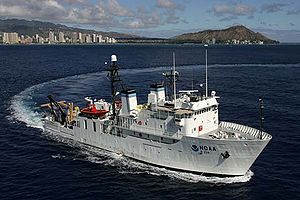NOAAS Hi'ialakai (R 334)
 NOAAS Hi'ialakai (R 334) off Honolulu, Hawaii, sometime between 2001 and 2009 | |
| Career (United States) | |
|---|---|
| Name: | Hi'ialakai |
| Namesake: | Hi'ialakai is a Hawaiian word meaning "Embracing Pathways to the Sea" |
| Builder: | Tacoma Boatbuilding Company, Tacoma, Washington |
| Laid down: | 14 April 1984 |
| Launched: | 1 June 1984 |
| Completed: | 21 November 1984 |
| Acquired: | October 2001 |
| Homeport: | Pearl Harbor, Hawaii |
| Status: | Active in NOAA Pacific Fleet |
| Notes: | Served in U.S. Navy Military Sealift Command as ocean surveillance ship USNS Vindicator (T-AGOS-3) 1984-1993; served in U.S. Coast Guard as medium endurance cutter USCGC Vindicator (WMEC-3) 1993-2001 |
| General characteristics | |
| Type: | ex-U.S. Navy Stalwart-class oceanographic research ship |
| Tonnage: | 1,486 gross register tons; 786 deadweight tons |
| Displacement: |
1,650 tons (light) 2,285 tons (full load) |
| Length: | 224 ft (68 m) |
| Beam: | 43 ft (13 m) |
| Draft: | 15 ft (4.6 m) |
| Installed power: | 1,600 horsepower (2.1 megawatts) |
| Propulsion: | Diesel-electric: Two General Electric 800-horsepower (1.1-megawatt) diesel engines, twin fixed-pitch propellers |
| Speed: | 11 knots |
| Range: | 8,000 nautical miles (14,816 kilometers) |
| Endurance: | 50 days |
| Boats and landing craft carried: | Five or six small work boats |
| Complement: | 24 (6 officers, 3 licensed engineers, and 15 other crew) plus up to 22 scientists |
| Sensors and processing systems: | Multibeam sonar; echosounder |
NOAAS Hi'ialakai (R 334) is an oceanographic research ship acquired by the National Oceanic and Atmospheric Administration (NOAA) in 2001.
Construction, acquisition, and commissioning
Hi'ialakai was laid down as the United States Navy Military Sealift Command Stalwart-class ocean surveillance ship USNS Vindicator (T-AGOS-3) on 14 April 1984 by the Tacoma Boatbuilding Company at Tacoma, Washington, and launched on 1 June 1984. Vindicator was delivered to the U.S. Navy on 26 November 1984. She was stricken from the Naval Vessel Register in 1993 and transferred to the United States Coast Guard, in which she served as medium endurance cutter USCGC Vindicator (WMEC-3).
In October 2001, Vindicator was transferred to NOAA. After conversion into an oceanographic research ship, she was commissioned into NOAA service as NOAAS Hi'ialakai (R 334).
Capabilities
Hi'ialakai is equipped with multibeam sonar and echosounder equipment for underwater mapping work. She is well-equipped to support both shallow- and deep-water dive projects. She carries five or six small work boats for transporting divers to and from working areas, multiple dive lockers to store scientific gear and equipment, a membrane Nitrox fill system for filling dive tanks, and a three-person, double-lock decompression chamber.
Career
Hi'ialakai is home-ported at Pearl Harbor, Hawaii. She operates in the Hawaiian Islands and the Pacific Insular Area, which includes American Samoa, the Commonwealth of the Northern Mariana Islands, and Guam.
Hi'ialakai supports the research of NOAA's National Ocean Service, National Marine Sanctuaries, National Marine Fisheries Service, and Office of Oceanic and Atmospheric Research, as well as that of the United States Fish and Wildlife Service and the University of Hawaii. She conducts coral reef ecosystem mapping, bio-analysis assessments, coral reef health studies, and fish stock studies. Her coral reef mapping supports a mapping effort initiated in 2002 by the United States Coral Reef Task Force. She carries out most of her dive-intensive operations in the Northwest Hawaiian Islands, which became the Papahanaumokuakea Marine National Monument, one of the largest marine conservation areas in the world, in 2006.
References
| NOAAS Hi'ialakai (R-334)
]]- NOAA Marine Operations NOAA Ship Hi'alakai
- NavSource Online: Service Ship Photo Archive USNS Vindicator (T-AGOS-3) USCGC Vindicator (WMEC-3) NOAA Hi'Ialakai (R-334)
- Wertheim, Eric, ed. The Naval Institute Guide to Combat Fleets of the World, 15th Edition: Their Ships, Aircraft, and Systems. Annapolis, Maryland: United States Naval Institute Press, 2007. ISBN 978-1-59114-955-2. ISSN 1057-4581.
| ||||||||

